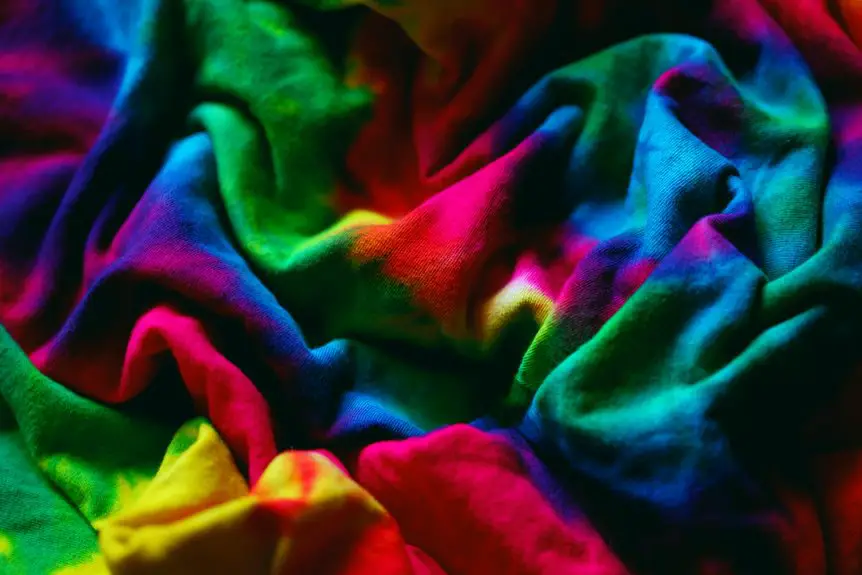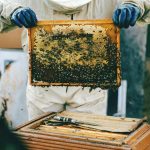Yes, you can tie-dye polycotton successfully by using fiber-reactive or disperse dyes made for blends. Start by pre-washing and soaking your fabric in soda ash to boost dye absorption. Keep it damp, bind tightly, and let the dye set covered for several hours. Rinse well and use a fixative to lock in color. Polycotton’s blend can dull vibrancy, but these steps help you get bright, lasting results. Learn how to master these techniques for your next project.
Table of Contents
Key Takeaways
- Yes, you can tie-dye polycotton; it requires special dye types and preparation for vibrant, lasting colors.
- Use fiber-reactive or disperse dyes designed for polycotton blends to achieve even and bright color absorption.
- Pre-soak fabric in soda ash solution and keep it damp for enhanced dye uptake and vivid color results.
- After dyeing, let the fabric set wrapped in plastic for 6-24 hours before rinsing to fix the colors properly.
- Rinse with cold water until clear, soak in a vinegar and salt fixative, and wash separately to maintain vibrancy.
Understanding Polycotton Fabric Composition
Polycotton blends cotton and polyester fibers to combine the best qualities of both materials.
When you work with polycotton, you’re dealing with a fabric that’s soft and breathable thanks to cotton, while also being durable and wrinkle-resistant because of polyester.
Typically, the blend ratio varies, but a common mix is 65% polyester and 35% cotton.
This combination affects how the fabric absorbs dyes—cotton fibers absorb color well, while polyester resists water-based dyes.
Understanding this mix is key to getting vibrant tie-dye results.
You’ll need to adjust your dyeing technique to accommodate polyester’s resistance and cotton’s absorbency.
Knowing the fabric’s composition helps you choose the right dyes and methods, ensuring your tie-dye project turns out bright, lasting, and beautiful.
Challenges of Tie-Dyeing Polycotton
Although tie-dyeing can be a fun and creative process, blending cotton and polyester fibers introduces specific challenges you need to address. Polycotton fabrics don’t absorb dye evenly because cotton and polyester react differently. This often results in muted or uneven colors. Additionally, standard tie-dye techniques might not work as effectively on blends, requiring adjustments in preparation and application.
| Challenge | Explanation |
|---|---|
| Uneven Dye Absorption | Cotton absorbs dyes; polyester resists them. |
| Color Vibrancy Loss | Polyester dulls overall color brightness. |
| Dye Fixation Difficulty | Polyester needs special treatment to fix dye. |
| Fabric Texture Change | Polyester affects fabric’s reaction to water and chemicals. |
| Limited Dye Options | Not all dyes bond well with blended fibers. |
Understanding these challenges helps you better prepare for successful tie-dyeing on polycotton.
Choosing the Right Dyes for Polycotton
Since polycotton blends react differently to dyes than pure fibers, you’ll need to select dyes specifically designed for mixed fabrics.
Fiber-reactive dyes are your best bet because they bond well with both cotton and polyester fibers, ensuring vibrant, lasting colors.
Fiber-reactive dyes deliver vibrant, long-lasting colors by bonding effectively with both cotton and polyester fibers.
Avoid using dyes meant solely for cotton or polyester, as they won’t produce even results on blends.
You can also find all-purpose dyes formulated for mixed fabrics, but these may not offer the same brightness or wash-fastness as fiber-reactive types.
When shopping, look for dye labels that mention compatibility with polycotton or blended materials.
Choosing the right dye sets the foundation for successful tie-dyeing, giving you bold, eye-catching patterns without fading or dullness.
Preparing Polycotton Fabric for Tie-Dye
Before you start tie-dyeing, you’ll want to prepare your fabric properly to guarantee the best results. Polycotton blends need special care to absorb dye evenly and prevent unwanted color spots.
Start by washing your fabric without fabric softener to remove any finishes or dirt that might block the dye. Keep the fabric damp before you apply the dye, as moisture helps the colors spread smoothly.
Finally, secure your fabric tightly with rubber bands to create distinct patterns.
- Wash fabric in warm water without fabric softener
- Leave fabric damp for better dye absorption
- Use rubber bands or string to bind fabric tightly
- Pre-soak fabric in soda ash solution for brighter colors
These steps set the stage for vibrant, long-lasting tie-dye on polycotton.
Essential Tools and Supplies for Tie-Dyeing
You’ll need a handful of essential tools and supplies to get started with tie-dyeing polycotton fabric.
First, grab fiber-reactive dyes, as they bond well with polycotton blends and deliver vibrant colors.
Squeeze bottles help you apply dye precisely.
Don’t forget rubber bands to secure your folds and create patterns.
Gloves protect your hands from stains, and plastic aprons or old clothes keep your outfit safe.
You’ll also want plastic bags or wrap to wrap your fabric during the dye-setting process.
Use a large plastic tub or sink for rinsing.
Finally, have soda ash on hand—it’s a fixative that improves dye absorption on polycotton fabrics.
These tools set you up for successful, colorful tie-dye projects.
Step-by-Step Tie-Dye Techniques for Polycotton
Mastering three simple tie-dye techniques can bring vibrant life to your polycotton fabric.
First, start by thoroughly wetting your fabric to help dye absorption.
Then, choose a method that suits your style:
- Spiral: Pinch the fabric center and twist tightly into a spiral, securing with rubber bands.
- Accordion Fold: Fold fabric back and forth in a fan shape, bind with rubber bands.
- Bullseye: Pinch a central point, pull upward, and bind at intervals along the length.
- Random Scrunch: Crumple fabric loosely for a textured, abstract pattern.
Apply dye generously to each section.
Let it set for 6-8 hours, then rinse and wash as directed.
These steps make your polycotton tie-dye project both fun and colorful!
Tips to Enhance Color Vibrancy on Blended Fabrics
Applying tie-dye techniques to polycotton blends can yield stunning results, but getting vibrant colors requires a bit more attention.
First, pre-wash your fabric without fabric softener to remove any residues that might block dye absorption. Use fiber-reactive dyes designed for polyester-cotton blends to guarantee better color adherence.
When mixing your dye, add a small amount of soda ash to boost the fabric’s ability to take in color. Apply dye generously and allow ample time for it to saturate the fabric fully.
Keep your fabric damp during application to help the dye spread evenly. Finally, avoid over-twisting or tightly binding your fabric, as this can prevent dye from penetrating all areas, resulting in dull patches.
These tips help you achieve bright, even colors on blended fabrics.
Setting the Dye for Long-Lasting Results
Although achieving vibrant colors on polycotton blends is essential, setting the dye properly secures those colors stay bright over time.
After applying the dye, you need to fix it to prevent fading and bleeding. Here’s how to set the dye effectively:
- Let your dyed fabric sit wrapped in plastic for 6-24 hours to allow proper absorption.
- Rinse the fabric in cold water until the water runs clear to remove excess dye.
- Soak your fabric in a fixative solution, like a vinegar and salt mix, to lock in colors.
- Wash the fabric separately in cold water with a mild detergent before regular use.
Following these steps guarantees your tie-dye on polycotton lasts longer and maintains its vividness.
Common Mistakes to Avoid When Tie-Dyeing Polycotton
You’ll want to avoid skipping proper fabric preparation, as it can prevent the dye from setting evenly.
Using the wrong type of dye can also lead to dull colors or poor fabric absorption.
Let’s explore how these common mistakes can impact your tie-dye results and how to prevent them.
Incorrect Fabric Preparation
Three common mistakes can sabotage your tie-dye project before you even start: skipping pre-washing, neglecting to remove sizing agents, and failing to dampen the fabric properly.
If you don’t pre-wash, dirt and oils block the dye from absorbing evenly. Sizing agents, often leftover from manufacturing, create a barrier that prevents vibrant colors.
Also, dry fabric doesn’t allow dyes to spread smoothly, resulting in patchy designs.
To prepare your polycotton fabric correctly, remember to:
- Pre-wash with a mild detergent to remove residues
- Avoid fabric softeners during washing
- Rinse thoroughly to get rid of sizing agents
- Dampen the fabric evenly before applying dye
Proper preparation sets the foundation for bright, long-lasting tie-dye results on your blended fabric.
Using Wrong Dye Types
When selecting dyes for your polycotton fabric, choosing the wrong type can ruin your design before you even start. Regular fiber reactive dyes work well on cotton but don’t bond properly with polyester fibers. If you use these alone, your colors will appear faded or uneven.
Instead, opt for disperse dyes or specially formulated poly-blend dyes designed to dye both fibers effectively. Avoid all-purpose or acid dyes, as they won’t produce vibrant, lasting results on polycotton.
Also, steer clear of cheap dye kits that don’t specify compatibility with blends. Using the right dye guarantees your colors stay bright and your patterns sharp.
Don’t skip this vital step—choosing the correct dye type is key to achieving professional-looking tie-dye on polycotton.
Creative Design Ideas for Polycotton Tie-Dye Projects
Although polycotton offers a unique blend of durability and softness, it also opens up exciting possibilities for tie-dye designs that stand out.
You can experiment with patterns that highlight the fabric’s texture and color absorption. Try these creative ideas to make your polycotton projects pop:
- Spiral patterns with contrasting colors to emphasize the blend’s vibrancy
- Ombre fades that showcase smooth color changes on the fabric
- Crumple techniques for a textured, marbled effect that adds depth
- Stripes or geometric shapes using rubber bands or stencils for precision
Frequently Asked Questions
Can Tie-Dyeing Damage Polycotton Fabric Integrity?
You won’t damage polycotton’s fabric integrity if you use the right dyes and follow care instructions. Avoid harsh chemicals and high heat, and your fabric will stay strong while showcasing vibrant, lasting tie-dye colors.
Is It Safe to Use Commercial Polycotton Clothing for Tie-Dye?
Think of commercial polycotton as a sturdy canvas; you can safely tie-dye it, but colors may not pop like on cotton. Use fiber-reactive dyes and prep your fabric well to get the best results without damage.
How Does Washing Affect Polycotton Tie-Dye Colors Over Time?
Washing your polycotton tie-dye can cause colors to fade gradually, especially if you use hot water or harsh detergents. You should wash in cold water and turn garments inside out to keep colors vibrant longer.
Are There Eco-Friendly Dyes Suitable for Polycotton Blends?
You can use eco-friendly fiber-reactive dyes designed for polycotton blends; they bond well and reduce environmental impact. Look for brands labeled non-toxic and biodegradable—they’ll help you achieve vibrant colors while staying green.
Can Tie-Dye Patterns on Polycotton Be Removed or Altered Later?
Like trying to erase a sunset, altering tie-dye on polycotton is tricky—you can’t fully remove colors, but you can tweak patterns with bleach or fabric paint. So, plan your design before making it permanent.
- Chanderi Silk Cotton: The Perfect Blend of Sheen and Comfort - June 25, 2025
- Is Chanderi Silk Good for Summer? Your Guide to Beating the Heat in Style - June 25, 2025
- How to Identify Pure Chanderi Silk: 5 Foolproof Tests - June 25, 2025







